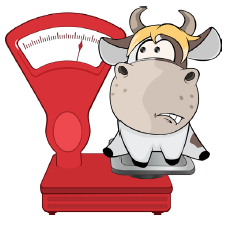Weighing time
This problem solving activity has a number and algebra (patterns and relationships) focus.
Mr and Mrs Watson and their son work on the dairy farm.
These are used to weigh cows and can’t weigh anything less than 100kg.
So Mr Watson says that they should get on the scales two at a time.
When they weigh Mr and Mrs Watson, the scales show 124 kg.
Mrs Watson and her son together weigh 140 kg.
Mr Watson and his son weigh 152 kg.
How heavy is each member of the family?
- Solve simultaneous equations.
- Devise and use problem solving strategies to explore situations mathematically (be systematic, use equipment, draw a diagram, use smaller cases, use algebra).
This problem requires students to find three unknown amounts from given number combinations. A solution can be found using a guess and improve method, by using logic and reasoning, by setting up algebraic equations, or by using a spreadsheet.
Whilst it is possible to solve the problem without using algebra, encouraging students to explore this method will extend their algebraic understanding and competency.
The Problem
Mr and Mrs Watson and their son work on the dairy farm. They are all getting overweight so weigh themselves on the only scales they have. These are used to weigh cows and can’t weigh anything less than 100kg. So Mr Watson says that they should get on the scales two at a time.
When they weigh Mr and Mrs Watson, the scales show 124 kg.
Mrs Watson and her son together weigh 140 kg.
Mr Watson and his son weigh 152 kg.
How heavy is each member of the family?
Teaching Sequence
- Pose the problem to the students.
- As groups work on the problem, you might suggest that they try guess and check or algebra. Encourage them to work systematically and keep a written record of their calculations.
- When appropriate, encourage students to try the extension problem.
- Share solutions as a class.
- Allow time for students to write up their solutions.
Extension
Is there an easier way to find the weights of the three Watsons?
Can you devise a system of weighing them that is easier to solve, given that the scales can’t weigh anything less than 100kg?
Can their weights be found in less than three weighings?
Solution
Method 1: Guess 50 kg for Mrs Watson. Then Mr Watson weighs 124 – 50 = 74 and the son weighs 140 – 50 = 90. But 90 + 74 = 164 > 152.
What information do we get from this? Can we use guess and improve now, rather than just making another wild guess? By choosing 50 kg for Mrs Watson we have got too big an answer for the other two. So we have to increase the weight of Mrs Watson.
Suppose that Mrs Watson was 60 kg. Then Mr Watson would be 64 and their son 80. Now 64 + 80 = 144 < 152. So Mrs Watson weighs something between 50 and 60 kg. As the error in weights was less with the 60 kg guess than maybe we should try our next guess closer to 60 than 50.
Keeping going like this we will eventually get the right answer.
Method 2: If we add all the three weighings together we will find twice the weight of the whole family. So the weight of the whole family is 416/2 = 208. Now Mr and Mrs Watson together weigh 124 kg so their son must weigh 208 – 124 = 84 kg. It’s straightforward then to see that Mrs Watson weighs 140 – 84 = 56 kg and Mr Watson weighs 140 – 84 = 68 kg.
Method 3: Set up three equations. Let Mrs Watson weigh f (for female) kg, Mr Watson weigh m kg and their son weigh s kg. Then
f + m = 124 (1)
f + s = 140 (2) and
s + m = 152 (3).
These equations can be solved by guess and check or by using a table in a spreadsheet. The guess and check method is essentially the same as Method 1, so we will solve the equations formally.
Adding them all together we get 2(f + m + s) = 416, so f + m + s = 208 (4). (Does this ring any bells?) Subtracting (1) from (4) gives s = 208 – 124 = 84. Substituting for s in (2) gives f = 140 – 84 = 56. Substituting for s in (3) gives m = 152 – 84 = 68.
It can also be solved algebraically by rearranging to find:
f = 124 -4 and s = 152 - m. Then we substitute these into f + s = 140 to get
124 - m + 152 - m = 140
276 - 2m - 140
m = 68.
Then f = 56 and s = 84.
Mrs Watson weighs 56kg, Mr Watson weighs 68 kg and their son weighs 84 kg. Do they sound overweight to you?
Solution to the Extension
If all three of them were weighed together and then two of the original weighings were made, then the calculations would be a little easier.
There are three people and therefore three unknowns. As we need three equations to find the three unknowns, we need to do three weighings. We have no other information of an informal nature that we can use here. It’s not like some Diophantine equations where we can use the fact that the numbers involved are integers.